QuestionQUESTION: My Nitrate, Nitrite, and hardness levels are high how can I lower them? I had the tank for two weeks.
My friends told me that Stress Zyme can lower NITRITE levels because of the bacteria in the product and also this product called Aquarium Pharmaceuticals Aquarium Salt can lower it as well. They also told me that for lowering NITRATE I have to use a product called Tetra Easy Balance Water Conditioner which has Nitraban, an additive that reduces nitrate levels in aquariums. I wanted to ask you first before adding these in. Will these lower the Nitrate and Nitrite?
And for hardness what do I do to lower this do I do more water changes or is their a product at pet store that can lower the hardness of water?
ANSWER: Good morning Thomas,
I'm really glad that you wrote me before adding this and that into your tank. This almost never works out...
If your tank is showing nitrite levels, this means one of two things. Either your tank has not finished cycling, or your setup (size of your tank and filter unit) is not able to support the amount of life you have living in it.
Please follow the link below to learn more about cycling:
http://freshaquarium.about.com/cs/biologicalcycle/a/nitrogencycle.htm
Also read this, which is a list of common first mistakes:
http://freshaquarium.about.com/od/aquariumstartup/a/newtankmistakes.htm
What you need to do is evaluate your setup. Do you have a filter that is turning over enough water per hour? This is greatly simplified by the manufacturer's packaging, but you have to be careful. If you have a 10 gallon tank, you can buy a filter rated for a 10 gallon tank, but that filter isn't going to do the trick if your tank has a goldfish in it - really no filter will be able to keep that tank clean! Truthfully, 10 gallons is too small for a single goldfish. 20-29 gallons would be much better, because goldfish are messy and needs lots of room along with ample filtration, to dilute and to process their metabolic wastes.
What's in your filter? The most efficient filters use a variety of biological media, to the best effect. AquaClear is the perfect example. Biological (ceramic rings) mechanical (sponges, which perform bio-filtration also) and chemical (carbon) filtration all works in unison. All of those surface areas (the ceramic rings, sponges, even the carbon - after it has been expended) provide hospitable areas for beneficial bacteria to colonize. I assure you they will do a much better job boosting your biological filtration than just some "bacteria additive". The only bacteria additive that I can assure you will work is refrigerated Bio-Spira, by Marineland. Bacteria in a bottle just doesn't work very well if it isn't kept alive by refrigeration. At best, it will provide an ammonia source which will kick start the nitrification process and have some soothing compounds that will encourage slime coat.
So nix the Stress Zyme. Instead, work on getting some more efficient filter media. The AquaClear filtration media comes in many sizes, and surely there is a size that fits your filter. I would use the Biomax (ceramic rings), skip the carbon, and just add an extra sponge, if you have room.
The fact that you have nitrates shows that the cycle is indeed, if not complete, then nearly complete. Just what do you have in your tank, and how big is it? This information is vital for me to say anything personalized about your tank. Right now I can just impart general information...
Easy Balance is a fine product to use if you are going on vacation and know that you aren't going to be able to do water changes for a couple of weeks. Otherwise, there is just no reason to use it. More water changes are definitely much more effective in lowering your nitrates than, once again, an additive in a bottle. So to lower your nitrates, perform 25% water changes every day until you see a significant drop. And most importantly, evaluate your stocking scheme...do you have too many fish? Are you perhaps overfeeding? Have you executed any water changes since the tank was first established? 20% per week is minimal, I try to encourage folks to do 50% water changes weekly. Nothing ensures healthy fish more than frequent partial water changes. Although diet matters a whole lot too...
Speaking of diet, what are you feeding these fish? Flakes and pellets tend to be high in protein (specifically animal protein) that's why most experts recommend they make up no more than 50% of the diet - with the exception of perhaps New Life Spectrum pellets which are formulated to be nutritionally complete and are very stable in H2O.
Here's a list of foods you can feed your fish:
http://fish.mongabay.com/food.htm
Again, it would be very helpful to know what kinds of fish you have. African cichlids, mollies, and goldfish are all primarily vegetarians and will fare poorly if fed a diet high in protein. Bettas and corydoras, on the other hand, are meat eaters and need meaty foods. The list goes on!
I hope that answers your question, sort of. In short, these additives may help in the short term, but in the long term the root of the problem will manifest itself again and again so it is much better to figure out *why* your nitrates are high in the first place, and perform frequent partial water changes with dechlorinator in the mean time. This will bring levels down eventually. The nitrite is especially troubling because this level is toxic to fish - hopefully you are not reading ammonia, as that is even more toxic...
What your friend said about aquarium salt has some basis in truth. While salt doesn't lower nitrite (really, nothing does, except for maybe Zeolite which *absorbs* nitrite and ammonia - it will shoot back up when it is expended) it does help for your fish to cope with nitrite toxicity. So while you are showing nitrites (and your fish are being, well, poisoned somewhat by nitrite exposure) it would be a good idea to add a little aquarium salt. Kosher or non-iodized cooking salt would work too, it's the same stuff. Add 1 teaspoon per 7-8 gallons, since this is a level most fish can tolerate. If you have a 10 gallon, add 1 1/2 teaspoons. I really do need to know the size of your tank, so please include that information if you write back.
Lastly, the hardness. Here's a tough one, I'll try to keep it simple. The hardness of your water is tied into the alkalinity of your water. Water that is very alkaline resists change - alkalinity "buffers" pH, so if your water is high in alkalinity chances are the pH is above neutral - 7.0 - and will stay there. For many fish, hard alkaline water is ideal. Livebearers, African cichlids, rainbowfish are a few fish that really thrive under these conditions.
If your water is soft (with a pH below neutral) it tends to be less alkaline, so the pH is prone to swings. That's why folks that keep soft water fish such as Discus, Angelfish, many tetras and South American cichlids, use reverse osmosis water and then add the necessary buffers to get the pH to a certain level below neutral. After they figure out how much of this and how much of that needs to be added, they add just that amount every time and have a perfect pH every time. Of course, most of us who "just want to keep fish" and not breed them or keep expensive, sensitive fishes - well, we just want to be able to change water, no fuss no muss.
So my strong recommendation, would be for you to choose fishes that like your hard water, or at least will tolerate it. Platies (also known as moons) and swordtails love these conditions, mollies and guppies are sensitive to water quality so avoid those at first. Other fish will tolerate these harder water conditions - barbs (rosy and gold barbs are some of my faves!) and many varieties of tetra (such as the X-ray tetra, black skirt/widow tetra, and red-eyed tetra varieties, for example) are in this group.
Adding buffers to soften the water usually do more hard than good. It's easier to harden soft water than it is to soften hard water, believe me! A solution in a bottle is not going to be a long-term one, and you can send all of your fishes into pH shock rather quickly with one well-meaning chemistry experiment...not pretty. So, unless you are serious about keeping fishes that will not tolerate hard water (such as Amazonian fishes or S.A. cichlids) then just don't worry about your hard water. It likely isn't a problem, since your local fish store probably has hard water too. Long-term softening of the water will require you to invest in an RO/DI unit (you can Google this term and check out the prices) which is more than likely unnecessary for your needs. And *definitely* do not add additives such as powders and liquids to soften the water. A local fish store with competent, helpful staff will advise you against this also (don't expect this kind of help from a chain store).
I hope that helps. Check out the home page of the links I included above, and also check out this site:
http://www.wetwebmedia.com
It has a search feature, which comes in very handy!
Take care, have a nice weekend! Feel free to write again, but please include more details about your setup.
Nicole
---------- FOLLOW-UP ----------
QUESTION: I have 2 5" inch goldfish in a 30 gallon. The ammonia levels are up and I use a fluval filter. How do I lower the ammonia levels also do water changes like you said or should I put something like chemicals you find at the petstore to remove the ammonia?
thank you for your help
AnswerHi Thomas,
While your tank isn't terribly overstocked, do be aware that it is overstocked. Goldfish tanks, and more specifically this tank, are difficult to keep clean. Goldfish are incredibly messy fish! They are best suited for ponds, and while you have them in a medium sized aquarium, a larger aquarium would definitely be better. If you bought them a 40 or 55 gallon tank, you would undoubtedly see a drop in ammonia and a growth in the fishes as a result. Their own wastes are inhibiting their growth, believe it or not!
Do not add ammonia removing chemicals. As I said before, chemicals, powders, "potions" and tonics might be useful in a few special circumstances, but there are always much better ways to spend your money. In the case of ammonia absorbers, do NOT use these. Zeolite, White Diamond, Ammo Chips - they are all the same thing and they are NOT recommended. What happens is they do their job - absorb ammonia! But this interferes with your beneficial bacteria, aka the process of nitrification in your tank. When the product is expended (a few days to a week) then you will be right back to where you started, often with a sudden jump in these toxic levels. So please, don't use these.
What you can do is this. Get yourself a cheap hang-on back filter. Walmart has some that will do the job nicely and are rated for a 30 gallon tank. I also am fond of the Penguin line of filters with the bio-wheel attachment, although these run a little pricier. Fill that hang-on back filter with a 10 oz. bag of Chemi-Pure and a foam sponge, like AquaClear makes (find the size that works for you). You can also use open cell-pore sponges from a craft store, OR filter floss from the pet store (which is not the same, but very similar to, polyester fiber fill from the craft store, also known as batting.) Adding extra flow to your tank, along with chemical media and extra mechanical/biological media, is going to help considerably. If it were me, I would go with the Chemi-Pure and sponge combination. When the sponge is dirty, just squeeze rinse it in cool water. Do not get it sparkly clean and *never* use bleach or detergents! The bacteria that make the sponge "work" need to be left undisturbed or a little dirty, if you will. Replace floss about every week or so. You may have to put it in a filter media bag depending on how much it breaks apart. That's why I like the floss from Petsmart - it stays together better.
I also recommend you use a bubble wand (or a large airstone that runs about the length of the back wall of your tank) and an air pump to add extra aeration to your aquarium. If you are using an airstone already, make sure it's big enough. Goldfish need cool (no higher than 70 degrees) well oxygenated water. They are coldwater fish, after all!
Please do, do those water changes! Right off the bat, you should do a 50% water change. Always add dechlorinator, of course. And every week, you should do a 60% water change or do a 30% water change twice a week. Remember, besides adding aeration by breaking the surface tension of the water, filters only help to keep the water cleaner so you can wait a bit longer between water changes. So do rinse that filter media in the Fluval once a month and do weekly, or better yet, twice weekly water changes. If you were to change 50% every two days, that would not be too much, so do not worry about changing too much water - goldfish breeders change 90% of their water weekly. They are just that messy!
Goldfish have somewhat specialized dietary needs, and changing their diet to a more natural diet will help keep your water cleaner. Adding aquarium plants such as Elodea (aka Anacharis) would help with the ammonia readings. Do read more here about goldfish diets and malnutrition:
http://www.kokosgoldfish.com/food.html
http://www.wetwebmedia.com/FWSubWebIndex/gldfshmalnut.htm
And check out these sites about goldfish keeping:
http://www.goldfishparadise.com
http://www.petlibrary.com/goldfish/goldfish.html
As well as the home pages of the sites I linked to, just above these two. Take care, I hope that helps!
Nicole

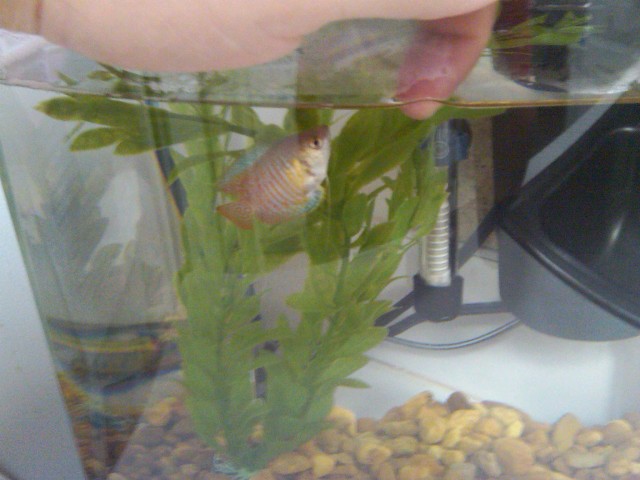 another question, and thanks for your help
QuestionQUESTION: Hi, Renee. I wanted to thank yo
another question, and thanks for your help
QuestionQUESTION: Hi, Renee. I wanted to thank yo
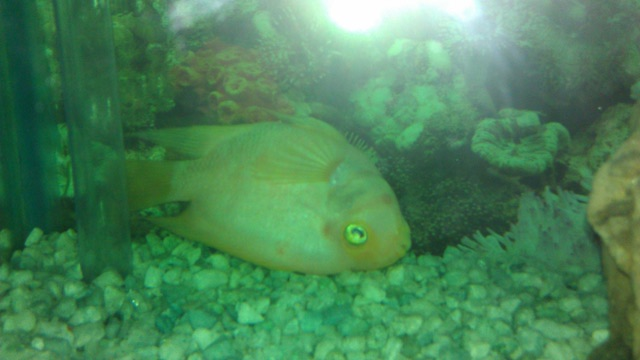 my 3 year old parrot stays upside down in the bottom of the tank.
Question
parrot laying upside d
Hello,
My parro
my 3 year old parrot stays upside down in the bottom of the tank.
Question
parrot laying upside d
Hello,
My parro
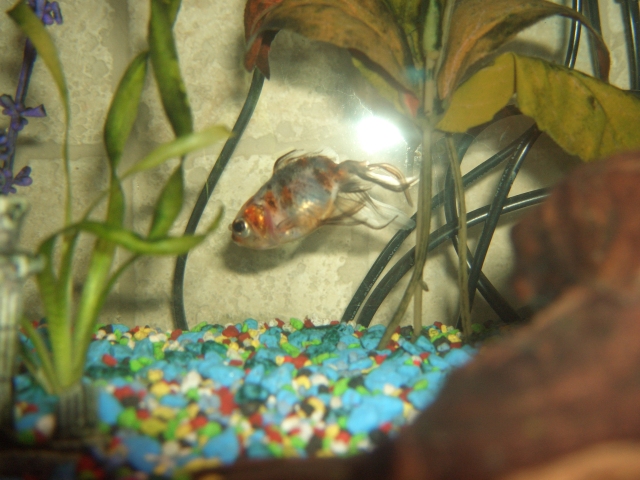 My sons Calico Orando - Bubbles!
QuestionBubbles
QUESTION: Weve had Bubbles for a
My sons Calico Orando - Bubbles!
QuestionBubbles
QUESTION: Weve had Bubbles for a
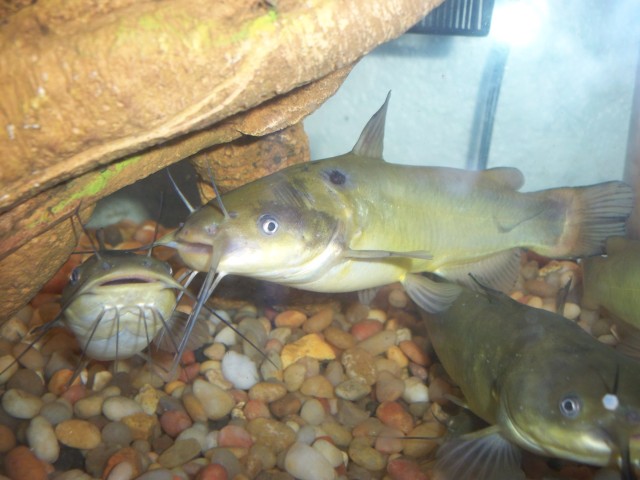 Spots and marks on catfish.
Question
Channel catfish
Hello,
I have 8 channe
Spots and marks on catfish.
Question
Channel catfish
Hello,
I have 8 channe
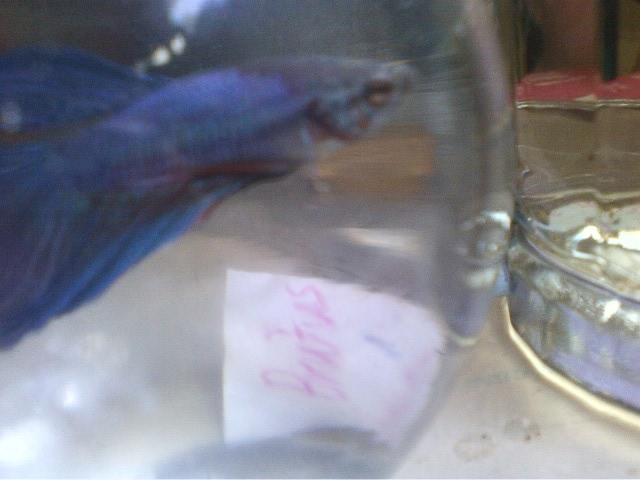 my beta has grey-ish green around his head
Question
beta closeup far off
I have had a
my beta has grey-ish green around his head
Question
beta closeup far off
I have had a